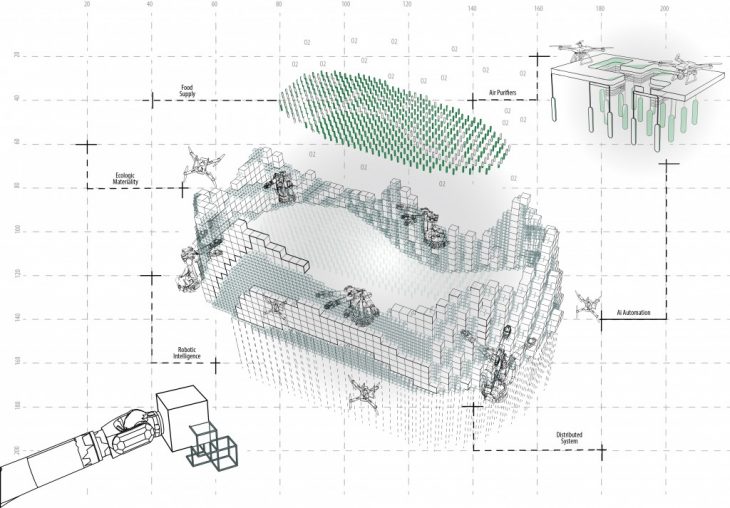SE.3 – Elective Seminar
FUTURE HOUSE
Faculty: Carmelo Zappulla
Teaching Assistant: Sebastian Amorelli
Students Assistant: Gabriele Luida Jureviciute
 The House of the Future
The House of the Future
Designing the house of future entails addressing some of the most dramatic environmental, social, economic issues that mankind has ever had to face up with in the course of its history, as, to
begin with, the house of the future will necessarily have to be integrated with the ecosystem a lot more than has ever happened so far, and, moreover, will also have to provide, in a sense, solutions to tremendous issues relating to energy, food production and human waste.
In what follows, I briefly illustrate the foremost issues that the course will tackle, as well as the envisaged potential solutions to such issues arising from the use of specific architectural and design strategies.
Artifacts from the future is orchestrated following an analytical, experimental and design methodology, proposing to use speculation as a tool to study the dynamics and explore the trend scenarios for our future, imagining and realising objects that will allow us to interact between ourselves and with our future habitat. At their core, all of the projects will explore temporality and spatiality in order to provoke novel design insights, to critique the present, and envision alternative potential futures.
1.Land and space scarcity
UN sources estimate that world population may rise to 11 billion people by the end of the century. This implies that there will be an ever-growing need for land and, in general, for space where to live. It should be noted that a great portion of the land currently available for agriculture is cultivated in a very inefficient way. Past ways to tackle the issue have included such controversial practices as birth control, and the use of intensive agriculture, but better and more efficient solutions may be on their way.
Solution(s): 1) parasitization or retrofitting of existing structure; 2) generation of new densely built communities; 3) reduction of meat consumption; 4) reduction of amounts of food waste.
2.Pollution problems
The level of CO2 and hydrocarbons-triggered pollution is constantly growing. Although a reduction of some forms of pollution has been affected in the last few years, others have, on the contrary, become even worse. A recent Max Planck Institute-coordinated study shows that, even if we adopted in full the existing clean-air legislation, air pollution’s death toll would nonetheless be bound to grow. So, we have practically reached a point of no return, which can just mean that the already adopted global policies (like those contained in the Paris protocol) should be more strictly implemented and possibly supplemented by harsher ones.
Solution(s): 1) use of sustainable materials and technology; 2) implementation of a circular economy, based on the widespread use of air purifiers, bio-photoreactors, nature integrated design strategies.
3. Energy and water crisis and food shortage
As is known, all-natural resources are in limited supply. Thus, we have the moral duty and obligation, in a sense, to view the spread of the use of renewable energetic sources as our main priority. Of course, the energy crisis is a very complex issue, which cannot be solely dealt with through the use of renewable energy sources. Humans will have to progressively learn to use such sources in an intelligent, ecologically sustainable, and essentially non-consumeristic way.
Solution(s): 1) integration of AI-controlled vertical and sustainable agriculture; 2) use of hydroponic plants and in-vitro cloned meat, insect and microalgae; 3) implementation of a sustainable management of clean water.
4. Migration
Migration is progressively becoming a pervasive, socially devastating phenomenon for many countries. The consequences of uncontrolled migration from poor to rich countries can hardly be underestimated: 1) political and economic turmoils; 2) instability; 3) wars; 4) growth of xenophobia and intolerance; 5) constant fights over land’s ownership and use. The problem, as pointed out by several scholars, is not that we don’t have enough space or land to share with the world’s poorest, but rather who will own what in the future society. Of course, as for other contemporary phenomena, one of the main causes of the massive migration from poor to rich countries is the impoverishment of land and the destruction of the external environment, and thus, precisely these issues should be viewed as fundamental to explain and understand the phenomenon.
Solution(s): 1) use of strategies leading to energetic self-sufficiency, and implementation of ecological protocols in developing and underdeveloped countries; 2) use of ‘second’, alternative economy as a source of employment and economic growth.
5. AI and IoT
Although this might be seen as a minor or sci-fi-rooted issue at the moment, in fact technological dependence and, in the future, the growing dependence from the AI, may deeply affect the way we live, from self-driving vehicles to smart structures. Of course, all predictions which foresee that machines will take over men very soon, or that the human civilisation will be led to complete demise by the machines are not likely. However, there is already ample room to fear that machines will significantly interfere with humans in a negative, pervasively disruptive, way. How will AI inform cities and architecture in the future?
The Internet of Things is set to surpass 50 billion connected devices by 2020. This exponentially growing network is creating an intricate ecosystem between ourselves and the devices that surround us, redefining the relationship between man and machine. The seamless interaction between humans and the technology that surrounds us will define and shape the spaces of the future. How will these relationships materialize?
Solutions: Turning a problem into opportunities where Ai can help human being to live a better and easier life: smart homes, smart structures, automation systems. Utilise the insurmountable amount of data generated by the IoT to optimise and make the life of inhabitant of the house of the future more efficient, productive and connected to its environment.